

The far left of the central staircase muralThe mural focuses at the top on the execution of Maximilian of the House of Hapsburg and his allies--Miguel Miramón and Tomás Mejía who supported French intervention and rule. Mexican conservatives had asked the Austrian archduke to rule Mexico, when Benito Juarez was constitutional president. When France withdrew its military support, Maximilian and his generals were captured and executed. The portrait head of Juarez is directly above that of Maximilian. | ||
The execution of Maximilian--1867Note that the imperial eagle of the Hapsburgs at the top left of the mural flies away from Mexico--toward Europe after Maximilian's death. |

|
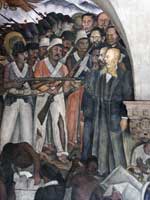
|
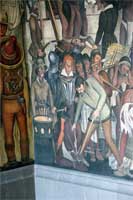
|
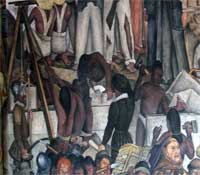
|
The branding of Indian slaves by Cortés' lieutenants; Indians constructing new buildings--like the Palacio Nacional as ordered by the Spanish |

|
||
The panel second from the leftCenter below--a Conquistador rapes an Indian woman and above him, examples of natives (Tlaxcaltecans) who sided with the Spanish; right below: an auto-da-fé during the Inquisition in this colony. The figure in glasses on the left side of the heretic is the archbishop Juan de Mendoza while the religious figure to the right is Pedro Moya de Contreras, first inquisitor, third archbishop and Viceroy of Mexico. | ||
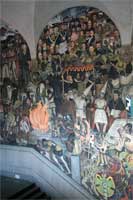
|
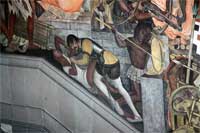
|
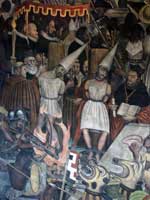
|
One of the repeated images in the murals of Hernán Cortés and La Malinche, his Mexican wife, with their son, a symbol of miscegenation after the Conquest; the fire--a representation of the destruction of Indian culture | ||
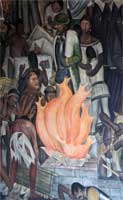
|

|
This fire alludes to the "burning of the codices by Fray Juan de Zumárraga in Texoco and to the destruction of Mayan manuscripts in Maní by Fray Diego de Landa" (Lozano and Rivera 225). |
The panel second from the left--top of the lobe: the Mexican Revolution (1910-20)The left side focuses on the dictatorship of Porfirio Diaz, whose policies handed over much of the country's resources to foreign companies. Note the background with various industries indicated. "One observer has estimated the vastness of these investments in the mid-1920s: 97 percent of mining sites, 50 percent of the oil industry, and 20 percent of the country's real estate were American-owned. The American presence prevented any sustained recovery on Mexico's part after the Revolution and kept the country, with its huge debts and paltry per capita income, in near-servitude to northern industrialists" (Lee 51). Shown in a row with raised swords are Porfirio Diaz, Victoriano Huerta, and Mondragón, Minister of War. Between Diaz and Huerta is the aristocratic Limantour, lawyer and Minister of the Treasury during Diaz' presidency; he was credited with stabilizing the nation's economy at the expense of the people. Other miinisters and governors are pictured on this left side of the top lobe. |
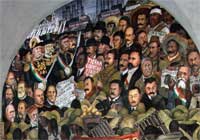
|
|
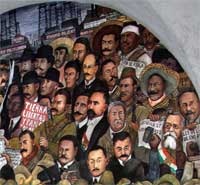
|
The panel second from the left--top of the lobe on the right: the leading RevolutionariesAt the top right Otilio Montaño is represented in his usual headband. He stands next to Emiliano Zapata, for whom he was a principal advisor, credited with originating the Ayala Plan. Down one row, hugging the arch is Pancho Villa in a dramatic sombrero sporting a macho mustache. Other anti-Porfirian leaders are depicted on this side including an artist, the engraver José Guadalupe Posada, who is painted with his sketckbook (bottom row, 5th from the right). |
|
 Go to Rivera Murals Index.
Go to Rivera Murals Index.
 Go to the Mexico Index.
Go to the Mexico Index.
 Click here to return to index of art historical sites.
Click here to return to index of art historical sites.
 Click here to return to index of artists and architects.
Click here to return to index of artists and architects.
 Click here to return to chronological index.
Click here to return to chronological index.
 Click here to see the home page of Bluffton University.
Click here to see the home page of Bluffton University.

